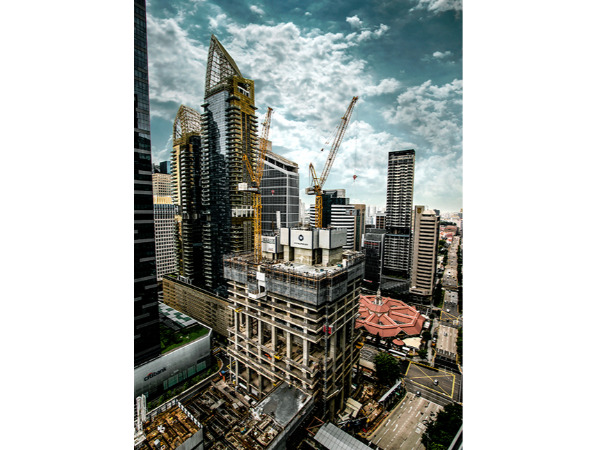
World first for Liebherr luffing jib cranes
The cranes started work in November 2020. Back then, the cranes belonging to the fleet of the Kim Soon Lee company were assembled freestanding at a tower height of around 40 metres. The Central Boulevard Towers are being built right next to the historic “Lau Pa Sat” building, also known as “Telok Ayer Market”. One of the two new towers will be approx. 241 metres in height. It’s for this part of the project that the two 710 HC-Ls, with jib lengths of 40 and 45 metres, are being used.
Limited space, lifts weighing several tonnes and a world first: Two new Liebherr luffing jib cranes are currently raising a 48-storey office building in the centre of Singapore. Internal climbing systems have been a successful part of high-rise building construction for a number of years now. What makes the Singapore project a world first is that the two 710 HC-L cranes are using a 24 HC 1000 tower system to climb up on the inside.
Local regulations and the layout of the site presented considerable challenges for the developers of a skyscraper project in Singapore. The solution involves two new Liebherr 710 HC-L luffing jib cranes, which are able to climb inside the building with the help of a 24 HC 1000 tower system.
Fewer climbing stages, less downtime
The two cranes will reach their maximum tower height of 245 metres in just ten climbing stages. This is made possible by a 57 metre-high tower. “The number of times a crane has to climb impacts how long the downtime is for customers,” says Liebherr Tower Cranes project manager Eric Konijn, stressing the advantages of this solution. “We were able to offer our customer a solution with ten climbing stages, which saves them valuable time and consequently money.” One climbing stage takes about two hours, so the cranes stand still for as short a time as possible. In addition, there are significantly fewer storeys to reinforce, which also has a positive impact on cost efficiency.
Due to the amount of guying that is legally required, and the resulting significantly increased costs, having the cranes climb completely on the outside of the building wasn’t a viable option. Plus, there isn’t enough space on site to use exterior climbing cranes.


 +91-22-24193000
+91-22-24193000 Subscriber@ASAPPinfoGlobal.com
Subscriber@ASAPPinfoGlobal.com